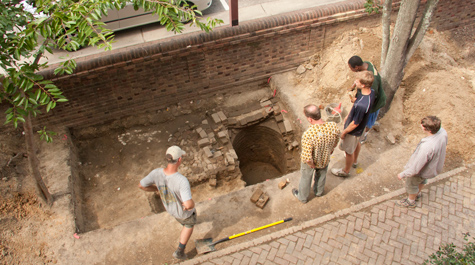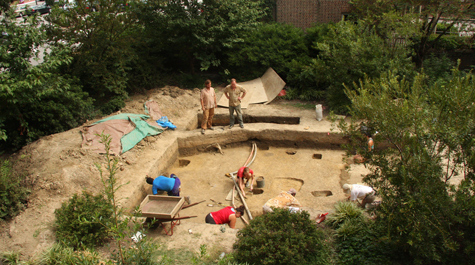Archaeologists close in on the 18th century Bray School
After a summer of excavation, archaeologists feel confident in saying that the 18th century Bray School once stood on the grounds of Brown Hall, a William & Mary dormitory.
The Bray School was a charitable enterprise dedicated to the religious education of free and enslaved African American children. It was founded in Williamsburg in 1760 and affiliated with William & Mary on the advice of Benjamin Franklin. Terry Meyers, Chancellor Professor of English at William & Mary, has conducted considerable scholarship tracing the histories of the school and the building that housed it, the Dudley Digges House at the corner of Prince George and Boundary streets.
More archaeology is necessary to confirm Meyers’ assertion that the original Bray School structure still stands, the original portion of a building moved from the site decades ago and now used by William & Mary’s Military Science Department. If Meyers is correct, the building is America’s oldest existing structure used for the education of black children.
William & Mary Assistant Professor of Anthropology Neil Norman and Mark Kostro, an archaeologist with the Colonial Williamsburg Foundation, were co-directors of the Bray School Archaeological Project (BSAP), a pair of 2012 summer field schools that searched for evidence of the Bray School on the grounds of Brown Hall. The initiative was jointly sponsored by the Colonial Williamsburg Foundation and William & Mary.
Both Kostro and Norman say that it’s quite possible for additional excavation and analysis to make an undoubted connection between the Bray School and the Military Science building. But they added that it’s also possible that the Bray School operated from a different building that stood on the site now occupied by Brown Hall and its grounds.
An extraordinarily rich dig site
Norman says that the site has proven to be rich with features. The field school uncovered remains representing the foundations of a number of buildings, but work to date has not uncovered remains of a foundation that matches up to the Military Science structure.
“We would have liked to have found the foundation on which that building once sat,” Kostro said. He added that it’s possible that the foundation was completely destroyed by the construction of Brown Hall in the 1930s, although the archaeologists hope that a portion of the foundation survived.
“Our work showed us that the construction of Brown Hall was much less destructive than we thought,” he added. “The ground is much better preserved than Neil or I expected. If we were given another season, we could work much nearer Brown Hall.”
They also discovered that Brown Hall does not have a full basement. Excavation under a crawl space area at one end could bring the missing foundation to light. If and when the Digges foundation is located, the archaeologists would concentrate on the area for artifacts and features related to education.
No ‘smoking lunchbox’ was found
The field school discovered plenty of artifacts this summer, but no “smoking lunchbox”—a definitive item that could make a solid connection to a school. A few slate pencil fragments were removed, but Norman says they are common artifacts, found in any number of Colonial-era sites. Other artifacts—some clay marbles and a small doll or figurine—show that children used the area.
“I’m very pleased. I think I would have been very disturbed if they had not found any artifacts that would point to children,“ Meyers said. “I understand that they can’t easily discern between a domestic site and a possible school site. I thought the finds at least allow the continued argument to proceed.”
Norman and Kostro are both eager and willing to proceed and are discussing plans for the resumption of the field school in the summer of 2013.
A well, discovered in the north yard of Brown Hall, offers potential for more telling artifacts. Norman explained that as wells went dry or sour, people would use them for discarding trash, making an old well an artifact magnet that can be mined profitably by modern archaeologists.
Getting down to where the pay dirt may be
The well remains an unknown quantity. Norman says it was constructed in either the 18th or 19th centuries. The archaeologists were able to excavate about seven feet down, a level, which held artifacts from the turn of the 18th century, mostly ceramics, bottle glass and other domestic refuse. The well could go another 30 feet before hitting the water table, he noted.
“The most interesting material in term of the Bray Project would be at the bottom of the well,” Norman said. “It holds the potential for cloth and bone to be preserved.”
He explained that the bottom of the well is likely to be an anaerobic environment, ideal conditions for preserving bones, cloth and similar fragile artifacts.
“The discovery of that well is just amazing,” Meyers said. “It gives them something to look into in the future. They haven’t got to the 18th century strata. When they get to that point, who knows what they might find?”
Full excavation of such a well is beyond the abilities of students in a field school, Norman added, as it requires bracing, pumps and the means to preserve artifacts that would begin to deteriorate as soon as they are removed from their anaerobic environment.
“You could find part of a waistcoat from the 18th century,” he said. “The clock starts running when you take it out of the well. It has to be conserved within a week or the cloth starts to disintegrate. The conservation costs money; the long-term care of the item costs money. We’d have to have some serious discussions before we take something like that on.”
The most interesting artifacts came from the highest levels of the well. Norman says that it appears that the well was filled and capped in the early 19th century, then disturbed during the construction of Brown Hall, and evidently covered only by boards.
The Coke bottle—the archaeologist’s friend
For the next few decades, residents treated the well much as the inhabitants of centuries earlier did, using it as a trash pit. The top layer yielded bottles that once held Coke and Mello Yello.
“Coke bottles are nice for archaeologists, because they have patent dates on them,” Norman notes. “We can tell that this bottle was used between 1938 and 1952.”
Other bottles recovered had once held stronger beverages. Several chromed pieces of cars came up, as did a few of desk finials and other bits and pieces of college life of the 30s to 60s. A room key, stamped “BH 305,” also came out of the well. Norman investigated and found that Brown Hall 305 still overlooks the well, although the locks were all changed.
Meyers suggested an intriguing explanation for the key’s presence in the well, in which a former resident of room 305 tossed the key out of the window to accommodate an unsanctioned entry by a boyfriend. The throw went awry or the catch was bobbled, and the key went into the well, to be recovered decades later.
 Skip to main content
Skip to main content


